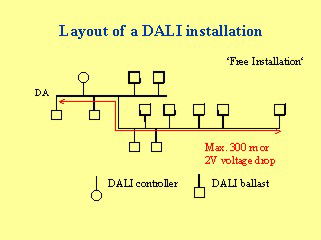Away from the purely domestic, building management systems (BMS) can incorporate special lighting control networks, as well as for control of heating and air-conditioning etc. An example is the major lighting-specific control protocol, Digital Addressable Lighting Interface (DALI):

DALI was originally developed to provide a standard lighting control protocol. This was because many lighting control manufacturers used their own proprietary protocols - many 'open' but others not. Architects, electrical contractors, engineers, facility managers, building owners and tenants can all can benefit from using DALI-enabled lighting systems, because of its inherent flexibility.
Typically, a DALI system comprises a ballast (which can operate from any manufacturer's DALI control units) and a multisensor, and the DALI protocol is based upon digital rather than the traditional analog signals. The great advantage is that lighting ballasts can be individually addressable (circuit addressability only is possible with analog systems). Also, bi-directional communication between each ballast and the control system is possible.
Other benefits include PIR movement-detection, constant light control and infrared (IR) remote operation. In addition, the various parts are very simply connected and configuration is easy. The latter can be achieved using the lighting control panel or, alternatively, an IR remote control device. Standard LV wiring connects ballasts to lighting controls, helping to keep costs to a minimum and making it easy to change layouts in the future.
Using DALI, lighting loads can be easily grouped and groups can be individually addressed. This is made easy by the IR remote control mentioned or by using Windows-based software. In this way, zoned or localised lighting control can be arranged very simply. Also, many separate DALI systems can be connected to BMS using gateways.
As communication is bi-directional, other benefits are conferred, such as being able to centrally monitor ballast operation, dimming levels, and also the identification of failed components such as ballasts and lamps.
It is this inherent flexibility that makes DALI so useful, especially to building and system designers - who can use it to help build on the 'smart' buildings theme. However, some lighting manufacturers still prefer to use their own protocols and complain, for example, that DALI can only cope with up to 64 addresses, and that its communication rate is relatively slow.
Go to www.dali-ag.org for more information.
Also click on: www.voltimum.co.uk/popup.php?url=doc_download.php%253Ffilename%253Dfiles/gb/others/1/2005070460388928ABB_DALI_for_Voltimum.PPT&subtitle=DALI%2520-%2520.PPT%2520-%25201.85MB